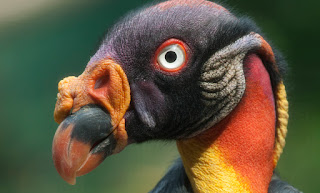I love collective nouns, and today I stumbled on this cluster of terms for vultures: a bunch of them generally—a committee, venue, or volt; in flight, a kettle; when feeding at a carcass, a wake.
But let's just look at vultures, which are beguiling and beautiful birds. There are 23 species altogether—16 in Europe, Asia, and Africa (such as the African hooded vulture shown here), in the Accipitridae family (which also includes eagles, kites, and hawks), and 7 in the Americas, all in the Cathartidae family. (Although many refer to vultures as "buzzards," those are actually a species of hawk in the Buteo genus, an error perpetrated by the first European settlers in North America, who looked up and saw black vultures and turkey vultures and misidentified them for the buzzards they knew back home.)All vultures feed on carrion. And that's about where the similarities between Old and New World species seem to end—except that they are all large, magnificent birds when seen in flight. And many—but not all—vultures have a naked head with no feathers. The Old World vultures all find their prey exclusively by sight, but many New World species have a remarkable sense of smell that allows them to zero in on food from great heights, up to a mile away.
Outside of the oceans, vultures are the only known obligate scavengers—meaning, they only eat dead (or almost dead) prey. When the hide of a carcass is too thick for them to open with their beak, they wait until another scavenger does the job for them. They may track the movements of mammal predators from aloft, in order to identify a possible next meal. An exceptionally corrosive stomach acid, which allows full digestion of prey (as well as dangerous bacteria), also prevents them from being eaten by lions, hyenas, cheetahs, and other scavengers. (The image here is a painting by John Banovich, Game of Lions.)
Vultures are key players in the Himalayan death ritual known as the "sky burial," or in Tibetan, བྱ་གཏོར (bya gtor), meaning literally "bird scattering" or "giving alms to the birds."
And of course, I must end (before a few more photos) with a note on their conservation status. A 2016 study found that of 22 species of vulture, nine are critically endangered, three are endangered, four are near threatened; the rest are doing okay. Of the endangered species, the threats are generally due to toxins in their prey; this includes lead from the bullets used in hunting (a leading cause of death among California condors), as well as, notably, the medicine diclenofac, which is fed to cattle and causes renal failure in vultures that feed on the cattle (this drug is now widely, though not yet completely, banned for veterinary use, thanks to efforts of Birdlife International). Another threat is intentional poisoning by poachers, who both object to the competition from the birds and are actively trying to keep vultures in check to avoid detection by game wardens, who use the circling birds to identify poachers' kills. Where vulture numbers have gone down, their scavenging services have on occasion been replaced by wild dogs, which then outcompete them, hindering their recovery. The diminishing practice of sky burials in Southeast Asia is also a leading reason for vultures' decline locally.
But let's end with some beauty—because they really are impressive birds (click on the images to see them large).
 |
| Griffon vultures (Gyps fulvus) |
 |
| Turkey vulture (Cathartes aura) |
 |
| White-backed vulture (Gyps africanus) |
 |
| Bearded vulture, aka lammergeier (Gypaetus barbatus), whose diet consists largely of bones |
 |
| Andean condor (Vultur gryphus) photo by Ferney Salgado |
 |
| King vulture (Sarcoramphus papa) |
And finally, a soaring California condor (Gymnogyps californianus) over the Grand Canyon:
,_Kruger_National_Park.jpg)



No comments:
Post a Comment